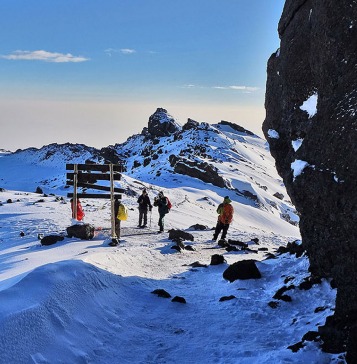- Moshi, Tanzania
- info@africafantasy.com
6-Day Umbwe Route
$2,315/Pax
Mountain Kilimanjaro
The Umbwe Route is the shortest and steepest path to Mount Kilimanjaro’s summit, making it one of the most challenging routes on the mountain. It is best suited for experienced trekkers who are confident in their fitness and ability to acclimatize quickly. The route begins with a dramatic ascent through a dense rainforest and offers stunning views of Kilimanjaro’s southern glaciers. While the 6-day itinerary is intense, it provides a direct and rewarding path to Uhuru
Peak, the highest point in Africa.
Price: $2,315
Duration: 9
Type: Mt Adventure
Age: 18-80

4.7
What’s Included
- Professional and experienced mountain guides, porters, and cooks.
- All park fees, camping fees, and rescue fees.
- High-quality camping equipment, including private tents and sleeping mattresses.
- All meals during the trek (breakfast, lunch, and dinner).
- Filtered drinking water and hot beverages.
- Transportation to and from Umbwe Gate.
- Two nights of accommodation in Moshi (before and after the trek).
- Emergency oxygen cylinder for altitude sickness.
- First aid kit and health monitoring with a pulse oximeter.
What’s Excluded
- International and domestic flights
- Travel insurance
- Tanzania visa fees.
- Personal trekking gear (e.g., sleeping bags, trekking poles, and warm clothing).
- Snacks, drinks, and personal expenses.
- Tips for guides, porters, and cooks.
- Optional accommodation upgrades in Moshi.
- Expenses for additional acclimatization days or side trips.
Join us for a journey that blends adventure, culture, and tranquility, crafted with care and passion for discovery. Tripzo exclusive expedition invites you to experience the world’s timeless wonders in a way that’s both unique and unforgettable.
Tour Plan
Day 1: Umbwe Gate to Umbwe Camp
The journey begins at Umbwe Gate with registration, followed by a steep ascent through a dense rainforest. The trail is narrow and winding, surrounded by towering trees and vibrant wildlife. Trekkers arrive at Umbwe Camp (2,850 meters) nestled in the forest for their first overnight stay.
Day 2: Umbwe Camp to Barranco Camp
The trail continues steeply upward, leaving the rainforest behind and entering the heather and moorland zone. This day offers panoramic views of the southern glaciers and the summit. The trek ends at Barranco Camp (3,900 meters), famous for its dramatic landscapes and the towering Barranco Wall.
Day 3: Barranco Camp to Karanga Camp
Trekkers start the day by climbing the iconic Barranco Wall, a steep but manageable ascent. The trail then levels out and passes through an alpine desert, ending at Karanga Camp (3,995 meters), a site with spectacular views of Kilimanjaro’s southern slopes.
Day 4: Karanga Camp to Barafu Camp
The trail continues through the alpine desert to Barafu Camp (4,673 meters), the base camp for the summit attempt. Trekkers arrive early to rest and prepare for the challenging midnight climb to the summit.
Day 5: Barafu Camp to Uhuru Peak and descend to Mweka Camp
The final ascent begins just after midnight under the starlit sky. Trekkers climb to Stella Point (5,745 meters) on the crater rim and push on to Uhuru Peak (5,895 meters), the highest point in Africa. After celebrating the summit, the descent begins, passing Barafu Camp before ending at Mweka Camp (3,068 meters).
Day 6: Mweka Camp to Mweka Gate
The final day involves a descent through lush rainforest to Mweka Gate. Successful climbers receive their certificates, and transportation is arranged back to Moshi for rest and celebration.
Tour Location
Reviews
FAQ’s
Frequently Asked Qeustion
1. How fit do I need to be to climb Kilimanjaro?
You don’t need technical climbing skills, but good physical fitness is essential. Training with cardio workouts, strength exercises, and hiking on uneven terrain will help improve endurance.
2. What is the best route to climb Kilimanjaro?
The most recommended routes are:
- Machame Route (6–7 days) – Scenic and popular.
- Lemosho Route (7–8 days) – Best for acclimatization.
- Marangu Route (5–6 days) – Has hut accommodations instead of tents.
- Rongai Route (6–7 days) – Less crowded and starts from the north side.
3. How do I avoid altitude sickness?
- Choose a longer route for better acclimatization.
- Follow the “climb high, sleep low” principle.
- Stay hydrated and maintain a steady pace.
- Consider taking Diamox (consult a doctor first).
4. What is included in a Kilimanjaro climb package?
Most packages include:
✅ Park fees & permits
✅ Professional guides & porters
✅ Accommodation (tents or huts)
✅ Meals & drinking water
✅ Safety equipment (oxygen, first aid kit)
5. When is the best time to climb Kilimanjaro?
- January–March: Cold but clear with fewer climbers.
- June–October: Best weather conditions but more crowded.
- April–May & November: Rainy season, making trails muddy and challenging.
We’re excited to connect and collaborate with you on innovative strategies that will shape the future of your brand.
- Newsletter
